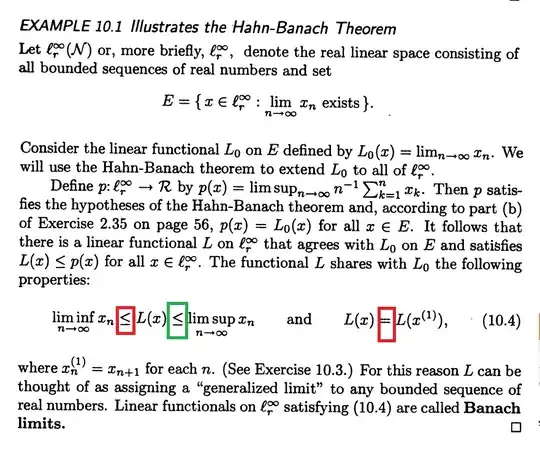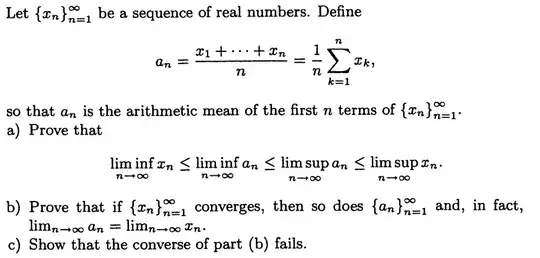I am trying to solve this exercise:
Let $\ell_\infty$ be the set of real infinite bounded sequences. Prove that there exists $\lambda \in (\ell_\infty)^*$ such that for all $a=(a_1,a_2,\ldots) \in \ell_\infty$:
$\liminf a_n \le \lambda(a)\le \limsup a_n$
$\lambda(a)=\lambda(L(a))$ where $L((a_1,a_2,a_3,\ldots))=(a_1,a_2,a_3,\ldots)$
I am trying to use the Hahn banbach extension theorem to solve this, but I am only partially able to solve it:
Lets say that we work on the subspace where we have convergence of the series, we define $\lambda(a)=\lim a_n$. As the sublinear function p we take $p(a)=\liminf a_n$. Then Hahn-Banach gives us directly that we can extend this linear function to the entire space, and we have that for any a in the space $\lambda(a)\le \liminf a_n$.
But what about the other inequality and the last part of the exercise? My idea was that using the same linear functionl, but now when we look at the usbspace of convering sequences we look at the linear functional $-\lambda$, and we take our sublinear function to be $p(a)=-\liminf a_n$. Then it looks like we are able to extend it to a functional on the entire space where $\lambda(a) \ge \liminf a_n$, but now we have lost the first part?(the $\limsup$) part. How to I extend the functional so that I am sure that both inequalities hold?
And what about the last part? I get that it holds on the subspace where we have convergence, but why does it hold when we extend?
Problem as an example in another book:
This problem is also given as an example in another book, there they use another sublinear functional. But I still have the same problem, the green inequality is the one I understand, the red I do not. It is given as en exercise in this book, and there is also a hint which I will show:
The hint given is relagted to an earlier exercise, in ordinary real analsyis that just deals with sequences:
But using this hint, I am still only able to get one inequality. Not the one with the $\liminf$, and also I am not able to get that $\lambda(a)=\lambda(L(a))$.
Any tips?

